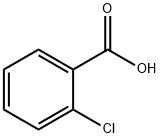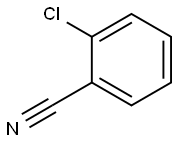Description
2-Chlorobenzoic acid is an organic compound with the formula ClC6H4CO2H. It is one of three isomeric chlorobenzoic acids, the one that is the strongest acid. This white solid is used as a precursor to a variety of drugs, food additives, and dyes.
Chemical Properties
2-chlorobenzoic acid is a white to pale cream crystals or powder, It is insoluble in water, 95% ethanol solution and toluene solution, soluble in methanol, anhydrous ethanol, ether, acetone and benzene.It is the intermediate of fungicide flubenthrinol, insecticide mirex and bollenuron, and acaricide tetrabenazine.
Uses
2-Chlorobenzoic acid was used to study the degradation of 2-bromobenzoic acid by
Pseudomonas aeruginosa.
Uses
The toxicity of halogenated benzoic acids was found to be directly related to the compound's hydrophobicity. Toxicity and quantitative structure-activity relationships of benzoic acids to Pseudokirchn
eriella subcapitata.
Uses
Preservative for glues, paints. Intermediate in the manufacture of fungicides and dyes.
Preparation
It is prepared by the oxidation of 2-chlorotoluene. The laboratory scale reaction employs potassium permanganate. Alternatively it arises by the hydrolysis of α,α,α-trichloro-2-toluene.
The chloride is readily replaced by ammonia to 2-aminobenzoic acid. At elevated temperature it decarboxylates.
Definition
ChEBI: 2-chlorobenzoic acid is a monochlorobenzoic acid having the chloro group at the 2-position. It has a role as a plant hormone and a plant metabolite. It is a monochlorobenzoic acid and a 2-halobenzoic acid. It is a conjugate acid of a 2-chlorobenzoate.
General Description
Crystals or fine fluffy white powder.
Air & Water Reactions
Insoluble in water.
Reactivity Profile
2-Chlorobenzoic acid is incompatible with strong oxidizing agents and strong bases.
Fire Hazard
Flash point data for 2-Chlorobenzoic acid are not available; however, 2-Chlorobenzoic acid is probably combustible.
Purification Methods
Crystallise the acid successively from glacial acetic acid, aqueous EtOH, and pet ether (b 60-80o). Other solvents include hot water or toluene (ca 4mL/g). The crude material can be initially purified by dissolving 30g in 100mL of hot water containing 10g of Na2CO3, boiling with 5g of charcoal for 15minutes, then filtering and adding 31mL of 1:1 aqueous HCl. The precipitate is washed with a little water and dried at 100o. [Beilstein 9 IV 956.]
Toxics Screening Level
The lTSL for o-chlorobenzoic acid has been changed from 0.04 μg/m3 to
0.1 μg/m3 based on an annual averaging time.





